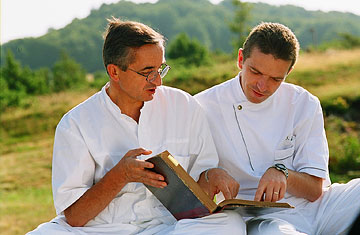
Chef Michel Bras, left, with his son Sébastien in Aubrac, central France
Paul Lacoste's new documentary, Entre les Bras (Step Up to the Plate), begins in 2009 when Michel Bras, the founder of an award-winning restaurant deep in the mountains of southern France, decides to gradually step down so his eldest son, Sébastien, can take up the chef's mantle.
In the second scene, as Michel creates his most famous dish, le gargouillou, it becomes clear why the transition will make for captivating drama. Michel is no less than a master. He dollops spoonfuls of lustrous purées — yellow and red pepper, black olive, sorrel — onto a white plate like paint to canvas, then adds scores of vegetables and a stunning array of handpicked local herbs and flowers — the leaves of red amaranth, valerian and mertensia, the petals of white roses, pansies and poppies. Michel's culinary talent, monklike devotion and encyclopedic knowledge of flora have made him a legend in France and earned his eponymous restaurant three Michelin stars.
Having previously filmed a documentary about Michel a decade earlier in his series on great French chefs, Inventing Cuisine, Lacoste returns to the Bras story at a critical turning point: Will the son be able to take the place of his father? Filmed over the course of a year, the scenes alternate between the buzzing kitchen and the stunning natural backdrop of the Aubrac plateau. Strains of minimalist piano give way to pregnant silences that test even the most patient art-house crowds. This is, after all, cinéma français. What's unexpected, though, is the suspense Lacoste generates.
Sébastien must prove to his father and himself (and the audience, which finds itself rooting for him) that he's capable of taking over the Bras family business while simultaneously finding his own culinary voice. In the kitchen, Sébastien appears paralyzed with doubt at times, which is compounded by Michel's constant remarks over his shoulder. ("You put the foie gras there. I would put it the other way," he says at one point. "Yeah, but I'm not left-handed!" retorts Sébastien.) When Sébastien begins creating a new dish for the menu, it becomes symbolic of his greater challenge as he must seek Michel's approval. Following Sébastien as he works and reworks the dish for months, the documentary provides a rare window into the mysterious creative process of a chef, as well as the passing of culinary traditions across generations.
As Sébastien labors, Michel Troisgros, himself the youngest in a family of great chefs, wonders if it's not the father's approval so much as his departure that Sébastien needs. "I think that Sébastien will show his true colors when Michel really retires," Troisgros says. But the question remains: Will Michel Bras ever truly retire? For the man who invented the liquid-center chocolate cake, handing over the keys does not preclude hanging around the kitchen. "The time I spend in the morning with the cooks is important for me," Michel confides one spring evening as he gazes over a landscape turned orange by the setting sun. "I told Séba, if I ever stop seeing them and stop going to the market, that'll be the end of me, I'll be dead."
Michel is by no means the only great chef to struggle with a late-career transition, as another arrestingly beautiful documentary proves — David Gelb's Jiro Dreams of Sushi, which was released this month in the U.S. At 85, Jiro Ono is considered the world's greatest sushi chef and his 10-seat basement eatery in Tokyo is the world's only three-Michelin-star sushi restaurant. Like Michel, Ono is driven by a belief he has more to give — and by a fear of slowing down. "Even at my age, after decades of work, I don't think I have achieved perfection," he says in the film.
Abandoned by his own father, Ono dishes out tough love with his sons. His youngest son, Takashi, recalls leaving to open his own restaurant. "My father said, 'Now you have no home to come back to,'" he said. "Failure was not an option." But it's the eldest son, Yoshikazu, who is under the most pressure. Tradition deems he will succeed his father, but Ono is now so legendary, says Hachiro Mizutani, his former apprentice, that even in death he will cast a shadow. "Even if Yoshikazu makes the same level of sushi, it will be seen as inferior," he says. "Sometimes when the father is too successful, the son can't surpass him."
Yet what Sébastien comes to realize is that he doesn't need to surpass his father, or to remake the restaurant, to become himself. "Why would I destroy everything just to build it all again?" he asks one frosty autumn morning. Which is why, by comparison, Entre les Bras seems the more refreshingly modern film, putting an uplifting spin on the familiar oedipal story. Sébastien at last perfects his dish by drawing from memories of childhood delicacies (Laguiole cheese, blackberry jam, milk skin and chocolate). By doing so, Sébastien doesn't reject, but rather pays homage to Michel, as well as his mother and grandmother, the three people who helped him develop his character and his palate. After he presents it to Michel, the chef scratches his head, "I don't get it." "Let me explain," Sébastien begins patiently. "This dish is the story of ... well, it's my story."
